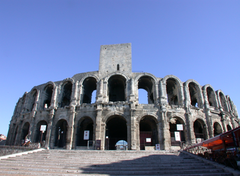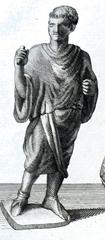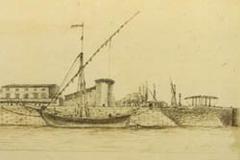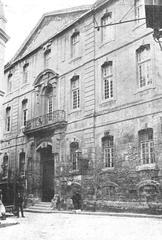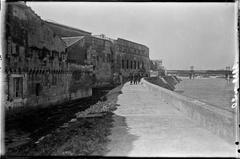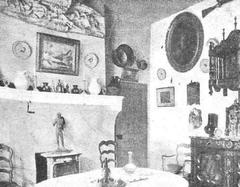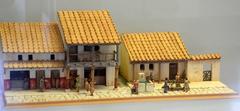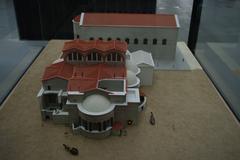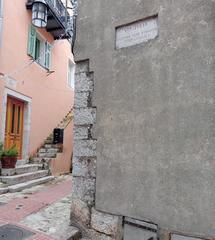Musée de la Camargue Visiting Hours, Tickets, and Travel Guide in Arles, France
Date: 04/07/2025
Introduction
Nestled within the Camargue Regional Natural Park near Arles, the Musée de la Camargue is a beacon of cultural and ecological discovery. Housed in the historic Mas du Pont de Rousty—a 19th-century sheepfold—the museum invites visitors to explore the dynamic interplay between nature, traditional livelihoods, and local heritage in the Rhône delta. Since its founding in 1979, the museum has evolved into a cultural hub, offering permanent and temporary exhibitions, immersive outdoor experiences, and educational activities that highlight the region’s biodiversity, agricultural history, and vibrant traditions. Whether you are an enthusiast of nature, history, or Provençal culture, the Musée de la Camargue provides an enriching experience that celebrates the harmonious coexistence of humanity and the wild landscapes of southern France. (Musée de la Camargue Official Site) (Eupedia on Camargue Biodiversity) (Arles Tourisme)
Table of Contents
- Overview of the Musée de la Camargue
- Practical Information for Visitors
- Highlights of the Camargue Region
- Museum Experience
- Visitor Tips and FAQs
- Planning Your Visit and Further Resources
Overview of the Musée de la Camargue
Origins and Historical Context
Situated in the heart of the Camargue, the museum tells the story of a unique European wetland where the Rhône River meets the Mediterranean Sea. The Camargue is renowned for its wetlands, salt flats, and exceptional biodiversity. The Musée de la Camargue reflects the region’s agricultural and pastoral traditions, as well as the centuries-long adaptation of local populations to the delta’s challenging environment. The museum was established in 1979 as a “musée de société,” aiming to highlight the interdependence between society and the environment—a mission closely linked to the creation of the Camargue Regional Nature Park in 1970.
Renovation and Modern Exhibitions
A major renovation in 2013 modernized the museum’s spaces and improved accessibility. The permanent exhibition, “Le fil de l’eau… le fil du temps en Camargue” (“The Thread of Water… the Thread of Time in Camargue”), uses artifacts, photographs, interactive displays, and audiovisual materials to trace the region’s development from prehistoric times to the present. Temporary exhibitions frequently feature contemporary artists, scientists, and environmental themes.
Thematic Focus
Museum exhibitions are organized around three core themes:
- Human Activities: Explore the everyday lives and traditions of Camargue inhabitants, including gardians (cowboys), fishermen, rice farmers, and salt workers.
- Identity and Territory: Examine local identity and its expression through costumes, rituals, and innovative land and water management.
- Environmental Dynamics: Understand the ongoing relationship between people and nature, including responses to climate change.
Practical Information for Visitors
Visiting Hours and Admission
- October to March: Daily except Tuesdays, 10:00–12:30 and 13:00–17:00.
- April to September: Daily except Tuesdays, 9:00–12:30 and 13:00–18:00.
- Closed: Tuesdays, January 1st, May 1st, and December 25th. Last entry is recommended at least one hour before closing. (cityzeum.com)
Admission Fees (as of February 2025)
- Standard: €7.50
- Reduced: €5 (youth 6–18, students, seniors 65+, job seekers, groups 10+)
- Free: Children under 6, persons with disabilities and their companions, journalists, teachers, ICOM members
- Family Passes: “Pass Maï” (2 adults + 3 youths) €28, “Pass Quatre” (2 adults + 2 youths) €23
- Free Entry: First Sunday of each month (February–November)
- Combined Passes: Available through Arles multi-site passes such as “Pass Avantage” and “Pass Liberté” (museedelacamargue.com)
Group visits (10+ people) require advance reservation, ideally two months in advance.
Getting There and Accessibility
- Location: Mas du Pont de Rousty, 8–10 km south of Arles on the D570 toward Saintes-Maries-de-la-Mer (cityzeum.com)
- Transport: Accessible by car (ample free parking for cars, campervans, and buses) and by regional bus. Check local schedules for public transport outside peak seasons.
- Accessibility: The museum is wheelchair accessible, with ground-floor exhibition spaces, adapted restrooms, and staff assistance. Holds the “Tourisme et Handicap” label for visitors with mobility, hearing, visual, and cognitive disabilities. The Discovery Trail is partially accessible.
Facilities and Amenities
- Restrooms: Including accessible facilities.
- Cloakroom: Limited; large bags are not allowed in exhibition areas.
- Shop: Offers books, local crafts, and Camargue souvenirs.
- Picnic Area: Outdoor tables are available.
- Audioguides: Available in several languages, including French and English.
Guided Tours and Special Events
- Guided Tours: Available for groups of 10+, with advance booking required. Regular guided visits (30 minutes) in French and sometimes other languages are included in admission.
- Workshops and Educational Activities: Family-friendly workshops and school programs are offered year-round.
- Special Events: Include birdwatching excursions, cultural workshops, and seasonal festivals.
Highlights of the Camargue Region
Ecological Landscape and Biodiversity
The Camargue, spanning over 100,000 hectares, is one of Europe’s richest wetland ecosystems (Eupedia):
- Birdlife: Over 400 species, including France’s only nesting colony of Greater Flamingos.
- Mammals, Amphibians, and Reptiles: 44 mammals, 10 amphibians, 15 reptiles.
- Iconic Animals: Free-roaming white Camargue horses and black bulls.
- Flora: Glasswort moors, salt steppes (turning red in autumn), reed beds, and rare riparian forests.
The wetlands are a vital stopover for 150,000 migratory birds annually, and 75% of all French bird species can be seen here (Avignon et Provence).
Traditional Livelihoods and Culture
- Rice Cultivation: The Camargue produces 99% of France’s rice. Flooded fields define the landscape and support rich biodiversity.
- Salt Production: Expansive salt ponds near Salin-de-Giraud have been harvested for centuries.
- Livestock Farming: “Manades” (herds) raise bulls and horses, central to cultural festivals and local identity.
Traditional festivals, such as the “Fête des Gardians” and “Feria d’Arles,” and the annual Roma pilgrimage to Saintes-Maries-de-la-Mer, celebrate the region’s vibrant culture (Arles Tourisme).
Conservation Efforts
Protected by the Camargue Regional Nature Park (since 1970) and the Camargue National Reserve (since 1927), the area is designated as an Important Bird Area and a Ramsar wetland of international significance (Eupedia).
Nearby Attractions
Combine your visit with other Arles highlights:
- Roman Amphitheater and Ancient Theater
- Musée départemental Arles Antique
- Réattu Museum
- Maison du Riz
- Van Gogh Trail The Camargue’s scenic roads and cycling paths offer further exploration opportunities.
Museum Experience
Permanent Exhibition
The museum’s central exhibition, “The Thread of Water, the Thread of Time in Camargue,” covers:
- The formation of the Rhône delta and its ecosystems
- Traditional Camargue life: farmhouse routines, rice and salt production, viticulture
- Water management and its impact on human settlement
- Gardian culture and animal husbandry
- Seasonal events, folklore, and crafts
The exhibition is interactive, with multimedia, historical artifacts, and hands-on displays suitable for all ages.
Temporary Exhibitions
Rotating exhibitions bring contemporary perspectives to environmental, cultural, and artistic topics.
2025 Highlight: “Atlas et herbier de Camargue”
From July 7 to November 2, 2025, this exhibition explores the region’s flora through cyanotype photography, poetry, and botanical research, fostering ecological awareness. Meet the authors on July 11, 2025 (Musée de la Camargue).
Outdoor Discovery Trail
The Discovery Trail (Sentier de découverte) is a free, marked path (3.5–4.8 km) starting at the museum. It passes through rice fields, marshes, reed beds, and saline steppe, with interpretive panels explaining wildlife and agriculture. Highlights include a reconstructed traditional Camargue hut, a marsh observatory, and opportunities for birdwatching and photography (whichmuseum.com).
Educational Programs
- Workshops: Hands-on family activities, especially during holidays.
- Morning Nature Walks: In July and August, naturalist-led walks at Domaine de la Palissade.
- School Visits: Programs tailored to students and educational groups.
Visitor Tips and Frequently Asked Questions
Visitor Tips
- Best Time to Visit: Spring and autumn for mild weather and abundant wildlife. Summer is hot—bring sun protection and water.
- What to Bring: Comfortable shoes, hat, sunscreen, binoculars, and a camera.
- Languages: Staff and materials are available in French and English.
- Accessibility: The Discovery Trail is mostly flat but may be muddy in places. Some sections can be challenging for strollers or wheelchairs.
FAQ
Q: What are the Musée de la Camargue opening hours?
A: See the seasonal schedule above; always confirm on the official website.
Q: How much do tickets cost?
A: Standard admission is €7.50 (from February 2025), with reduced rates and free categories.
Q: Is the museum accessible?
A: Yes, with adapted facilities and staff assistance.
Q: Can I buy tickets online?
A: Tickets are primarily sold on-site; group reservations require advance booking.
Q: Is the Discovery Trail free?
A: Yes, it is free and open year-round.
Q: Are pets allowed?
A: Pets are not permitted inside the museum or protected natural areas.
Planning Your Visit and Further Resources
- Website: museedelacamargue.com
- Phone: +33 (0)4 90 97 10 82
- Email: [email protected]
For group bookings and special events, advance reservations are recommended.
Related articles:
(Replace # with actual internal links on your site.)
Discover More and Stay Connected
The Musée de la Camargue offers a gateway to one of Europe’s most remarkable natural and cultural landscapes. Through its permanent and temporary exhibitions, outdoor discovery trail, and commitment to sustainability and local engagement, the museum brings the Camargue’s biodiversity and heritage to life. To maximize your visit, download the Audiala app for interactive guides, explore related posts for more travel inspiration, and follow the museum and Arles tourism on social media for the latest updates and special events. (Musée de la Camargue Program) (Petit Futé on Musée de la Camargue) (Cityzeum Visitor Guide)
References
- Musée de la Camargue: Visiting Hours, Tickets, and Exploring Arles’ Historic Delta Region, 2025, (Musée de la Camargue Official Site)
- Discover the Camargue: Visiting Hours, Tickets, and Highlights of Arles’ Unique Cultural and Ecological Treasure, 2025, (Arles Tourisme)
- Musée de la Camargue Visiting Hours, Tickets, and Visitor Guide – Arles Historical Site, 2025, (Cityzeum Visitor Guide)
- Musée de la Camargue Visiting Hours, Tickets, and Exhibitions in Arles, 2025, (Petit Futé on Musée de la Camargue)
- Eupedia: Camargue Biodiversity, 2025, (Eupedia)
- Tales from the Lens: Things to Do in Camargue, 2025, (Tales from the Lens)
- Arles City Guide Spring Program, 2025, (Arles City Guide)

